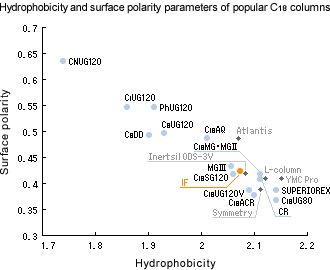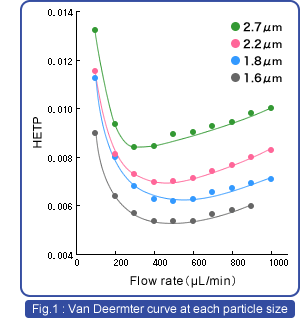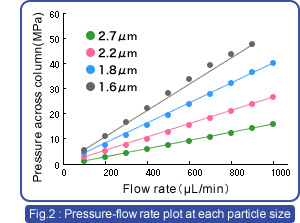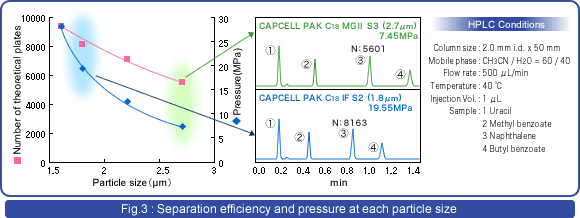
|
|
 |
|
The Birth of IF - Osaka Soda Challenge in Elevated Pressure -
|
|
|
IF, an acronym for Ideally Fine particles, was developed through comprehensive optimization studies.
|
|
|
|
 |
|
Hydrophobicity and surface polarity parameters
|
The figure on the left is the hydrophobicity-polarity plot of stationary phases. CAPCELL PAK C
18 IF, showing moderate values for both parameters among other CAPCELL PAK phases, seems applicable to a wide variety of compounds.
|
 |
|
Features
|
-
Large number of theoretical plates (small particle size)
-
Small height of theoretical plate at high flow rate
-
High pressure limit (40 MPa, or 5800 psi)
 |
|
What does a small particle size bring to separation efficiency?
|
A height of theoretical plate (HETP) is a column length necessary to generate one theoretical plate (HETP = L/N). The shorter a height of theoretical plate is, the more efficient a stationary phase is. HETP is also expressed as A x
d + B/u + C x d2 x u, where d and u are particle diameter of packing material and linear velocity of mobile phase, respectively, and A, B, and C are constants. The formula implies that the obtainable separation efficiency is directly
affected by particle size and chromatographic conditions.
 |
|
How do particle size and flow rate affect pressure?
|
Pressure increases in proportion to flow rate and the inverted square of particle size. Efficiency earned by a small particle size and the time saved at a high flow rate are always accompanied by the corresponding pressure increase.
Chromatographic conditions should be arranged by making a compromise among these factors.
|
|
|
|
 |
|
The concept of CAPCELL PAK C
18 IF
|
While "2-micron" products available in the market show a great deal of difference in particle size, the particle size of CAPCELL PAK IF has been optimized to 1.8 microns, the size determined under the best balance between efficiency
and pressure. In addition, its chemical structure provides a nature to keep a separation efficiency over a wide range of flow rate. The figure below shows the relationship between particle size and number of theoretical plates at 500 μL/min.
|
|
· Excellent durability for biological samples
|

|
|
|
· Also available worldwidely
|
|
|
· Categorized as L1 in USP
|
|
|
 |
|
Property values
|
Pore size
(nm)
|
Particle size
(μm)
|
Specific Surface area
(m
2/g)
|
C%
|
Density
(μmol/m
2)
|
Functional group
|
Acceptable pH
|
|
12
|
2
|
340
|
14
|
1.9
|
Octadecyl group
|
2-9
|





